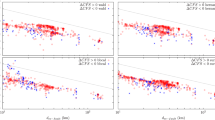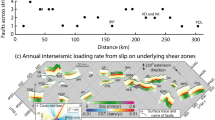Abstract
Stress changes in the crust due to an earthquake can hasten the failure of neighbouring faults and induce earthquake sequences in some cases1,2,3,4,5. The 1999 Hector Mine earthquake in southern California (magnitude 7.1) occurred only 20 km from, and 7 years after, the 1992 Landers earthquake (magnitude 7.3). This suggests that the Hector Mine earthquake was triggered in some fashion by the earlier event. But uncertainties in the slip distribution and rock friction properties associated with the Landers earthquake have led to widely varying estimates of both the magnitude and sign of the resulting stress change that would be induced at the location of the Hector Mine hypocentre—with estimates varying from -1.4 bar (ref. 6) to +0.5 bar (ref. 7). More importantly, coseismic stress changes alone cannot satisfactorily explain the delay of 7 years between the two events. Here we present the results of a three-dimensional viscoelastic model that simulates stress transfer from the ductile lower crust and upper mantle to the brittle upper crust in the 7 years following the Landers earthquake. Using viscoelastic parameters that can reproduce the observed horizontal surface deformation following the Landers earthquake, our calculations suggest that lower-crustal or upper-mantle flow can lead to postseismic stress increases of up to 1–2 bar at the location of the Hector Mine hypocentre during this time period, contributing to the eventual occurrence of the 1999 Hector Mine earthquake. These results attest to the importance of considering viscoelastic processes in the assessment of seismic hazard8,9,10,11.
This is a preview of subscription content, access via your institution
Access options
Subscribe to this journal
Receive 51 print issues and online access
$199.00 per year
only $3.90 per issue
Buy this article
- Purchase on Springer Link
- Instant access to full article PDF
Prices may be subject to local taxes which are calculated during checkout




Similar content being viewed by others
References
Stein, R. S., King, G. C. P. & Lin, J. Change in failure stress on the southern San Andreas fault system caused by the 1992 magnitude = 7.4 Landers earthquake. Science 258, 1328–1332 (1992).
King, G. C. P., Stein, R. S. & Lin, J. Static stress changes and the triggering of earthquakes. Bull. Seismol. Soc. Am. 84, 935–953 (1994).
Deng, J. & Sykes, L. R. Triggering of 1812 Santa Barbara earthquake by a great San Andreas shock: Implications for future seismic hazards in southern California. Geophys. Res. Lett. 23, 1155–1158 (1996).
Harris, R. A., Simpson, R. W. & Reasenberg, P. A. Influence of static stress changes on earthquake locations in southern California. Nature 375, 221–224 (1995).
Stein, R. S. The role of stress transfer in earthquake occurrence. Nature 402, 605–609 (1999).
US Geological Survey, Southern California Earthquake Center, and California Division of Mines and Geology. Preliminary report on the 16 October 1999 M 7.1 Hector Mine, California, earthquake. Seismol. Res. Lett. 71, 11–23 (2000).
Parsons, T. & Dreger, D. S. Static-stress impact of the 1992 Landers earthquake sequence on nucleation and slip at the site of the 1999 M = 7.1 Hector Mine earthquake, southern California. Geophys. Res. Lett. 27, 1949–1952 (2000).
Pollitz, F. F. & Sacks, I. S. Consequences of stress changes following the 1891 Nobi earthquake, Japan. Bull. Seismol. Soc. Am. 85, 796–807 (1995).
Pollitz, F. F. & Sacks, I. S. The 1995 Kobe, Japan, earthquake: A long-delayed aftershock of the offshore 1944 Tonankai and 1946 Nankaido earthquakes. Bull. Seismol. Soc. Am. 87, 1–10 (1997).
Freed, A. M. & Lin, J. Time-dependent changes in failure stress following thrust earthquakes. J. Geophys. Res. 103, 24393–24409 (1998).
Deng, J., Hudnut, K., Gurnis, M. & Hauksson, E. Stress loading from viscous flow in the lower crust and triggering of aftershocks following the 1994 Northridge, California, earthquake. Geophys. Res. Lett. 26, 3209–3212 (1999).
Stein, R. S. & Lisowski, M. The 1979 Homestead Valley earthquake sequence, California: Control of aftershocks and postseismic deformation. J. Geophys. Res. 88, 6477–6490 (1983).
Oppenheimer, D. H., Reasonberg, P. A. & Simpson, R. W. Fault plane solutions for the 1984 Morgan Hill, California, earthquake sequence: Evidence for the state of stress on the Calavares fault. J. Geophys. Res. 93, 9007–9026 (1988).
Reasenberg, P. A. & Simpson, R. W. Response of regional seismicity to the static stress change produced by the Loma Prieta earthquake. Science 255, 1687–1690 (1992).
Toda, S., Stein, R. S., Reasonberg, P. A. & Dieterich, J. H. Stress transferred by the M w = 6.5 Kobe, Japan, shock: Effect on aftershocks and future earthquake probabilities. J. Geophys. Res. 103, 24543–24565 (1998).
Stein, R. S., King, G. C. P. & Lin, J. Stress triggering of the 1994 M = 6.7 Northridge, California, earthquake by its predecessors. Science 265, 1432–1435 (1994).
Jaume, S. C. & Sykes, L. R. Evolution of moderate seismicity in the San Francisco Bay region, 1850 to 1993: seismicity changes related to the occurrence of large and great earthquakes. J. Geophys. Res. 101, 765–789 (1996).
Shen, Z. et al. Postseismic deformation following the Landers earthquake, California, 28 June 1992. Bull. Seismol. Soc. Am. 84, 780–791 (1994).
Massonnet, D., Thatcher, W. & Vadon, H. Detection of postseismic fault-zone collapse following the Landers earthquake. Nature 382, 612–616 (1996).
Savage, J. C. & Svarc, J. L. Postseismic deformation associated with the 1992 M w = 7.3 Landers earthquake, Southern California. J. Geophys. Res. 102, 7565–7577 (1997).
Jackson, D. D., Shen, Z. K., Potter, D., Ge, X. B. & Sung, L. Y. Geoscience: Southern California deformation. Science 277, 1621–1622 (1997).
Bock, Y. et al. Southern California permanent GPS geodetic array: Continuous measurements of regional crustal deformation between the 1992 Landers and 1994 Northridge earthquakes. J. Geophys. Res. 102, 18013–18033 (1997).
Peltzer, G., Rosen, P., Rogez, F. & Hudnut, K. Poro-elastic rebound along the Landers 1992 earthquake surface rupture. J. Geophys. Res. 103, 30131–30145 (1998).
Ivins, E. R. Transient creep of a composite lower crust, 2. A polymineralic basis for rapidly evolving postseismic deformation modes. J. Geophys. Res. 101, 28005–28028 (1996).
Deng, J., Gurnis, M., Kanamori, H. & Hauksson, E. Viscoelastic flow in the lower crust after the 1992 Landers, California, earthquake. Science 282, 1689–1692 (1998).
Pollitz, F. F., Peltzer, G. & Bürgmann, R. Mobility of continental mantle: Evidence from postseismic geodetic observations following the 1992 Landers earthquake. J. Geophys. Res. 105, 8035–8054 (2000).
Kirby, S. H. & Kronenberg, A. K. Rheology of the lithosphere: Selected topics. Rev. Geophys. 25, 1219–1244 (1987).
Hauksson, E., Jones, L. M., Hutton, K. & Eberhart-Phillips, D. The 1992 Landers earthquake sequence: Seismological observations. J. Geophys. Res. 98, 19835–19858, (1993).
Wald, D. J. & Heaton, T. H. Spatial and temporal distribution of slip for the 1992 Landers, California, Earthquake. Bull. Seismol. Soc. Am. 84, 668–691 (1994).
Dreger, D. & Kaverina, A. Seismic remote sensing for the earthquake source process and near source strong shaking: A case study of the October 16, 1999 Hector Mine Earthquake. Geophys. Res. Lett. 27, 1941–1944 (2000).
Acknowledgements
We thank S. Sacks for discussions and S. Keiser for computer support. This research was supported by a NSF post-doctoral fellowship and the Southern California Earthquake Center.
Author information
Authors and Affiliations
Corresponding author
Rights and permissions
About this article
Cite this article
Freed, A., Lin, J. Delayed triggering of the 1999 Hector Mine earthquake by viscoelastic stress transfer. Nature 411, 180–183 (2001). https://doi.org/10.1038/35075548
Received:
Accepted:
Issue Date:
DOI: https://doi.org/10.1038/35075548
This article is cited by
-
Heterogeneous rheology of Japan subduction zone revealed by postseismic deformation of the 2011 Tohoku-oki earthquake
Progress in Earth and Planetary Science (2023)
-
Seismicity and Fault Interaction in the Gulf of Aqaba
Pure and Applied Geophysics (2023)
-
A machine learning algorithm with random forest for recognizing hidden control factors from seismic fault distribution
Geosciences Journal (2023)
-
Spatio-temporal clustering of successive earthquakes as inferred from analyses of global CMT and NIED F-net catalogs
Earth, Planets and Space (2022)
-
Oblique fault movement during the 2016 Mw 5.9 Zaduo earthquake: insights into regional tectonics of the Qiangtang block, Tibetan Plateau
Journal of Seismology (2020)
Comments
By submitting a comment you agree to abide by our Terms and Community Guidelines. If you find something abusive or that does not comply with our terms or guidelines please flag it as inappropriate.



